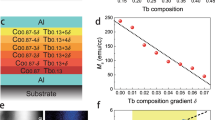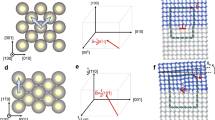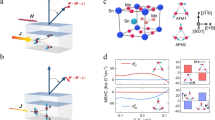Abstract
Spin–orbit torque (SOT)-driven deterministic control of the magnetic state of a ferromagnet with perpendicular magnetic anisotropy is key to next-generation spintronic applications including non-volatile, ultrafast and energy-efficient data-storage devices. However, field-free deterministic switching of perpendicular magnetization remains a challenge because it requires an out-of-plane antidamping torque, which is not allowed in conventional spin-source materials such as heavy metals and topological insulators due to the system’s symmetry. The exploitation of low-crystal symmetries in emergent quantum materials offers a unique approach to achieve SOTs with unconventional forms. Here we report an experimental realization of field-free deterministic magnetic switching of a perpendicularly polarized van der Waals magnet employing an out-of-plane antidamping SOT generated in layered WTe2, a quantum material with a low-symmetry crystal structure. Our numerical simulations suggest that the out-of-plane antidamping torque in WTe2 is essential to explain the observed magnetization switching.
This is a preview of subscription content, access via your institution
Access options
Access Nature and 54 other Nature Portfolio journals
Get Nature+, our best-value online-access subscription
$29.99 / 30 days
cancel any time
Subscribe to this journal
Receive 12 print issues and online access
$259.00 per year
only $21.58 per issue
Buy this article
- Purchase on Springer Link
- Instant access to full article PDF
Prices may be subject to local taxes which are calculated during checkout




Similar content being viewed by others
Data availability
All the data supporting the findings of this study are available in the article and its Supplementary Information. Further information is available from the corresponding author on reasonable request.
References
Miron, I. M. et al. Perpendicular switching of a single ferromagnetic layer induced by in-plane current injection. Nature 476, 189–193 (2011).
Liu, L. et al. Spin–torque switching with the giant spin Hall effect of tantalum. Science 336, 555–558 (2012).
Liu, L. et al. Current-induced switching of perpendicularly magnetized magnetic layers using spin torque from the spin Hall effect. Phys. Rev. Lett. 109, 096602 (2012).
Mellnik, A. R. et al. Spin-transfer torque generated by a topological insulator. Nature 511, 449–451 (2014).
Brataas, A. et al. Current-induced torques in magnetic materials. Nat. Mater. 11, 372–381 (2012).
Liu, R. H. et al. Spectral characteristics of the microwave emission by the spin Hall nano-oscillator. Phys. Rev. Lett. 110, 147601 (2013).
Cheng, R. et al. Terahertz antiferromagnetic spin Hall nano-oscillator. Phys. Rev. Lett. 116, 207603 (2016).
Garello, K. et al. Symmetry and magnitude of spin–orbit torques in ferromagnetic heterostructures. Nat. Nanotechnol. 8, 587–593 (2013).
Yu, G. et al. Switching of perpendicular magnetization by spin–orbit torques in the absence of external magnetic fields. Nat. Nanotechnol. 9, 548–554 (2014).
Chen, S. et al. Free field electric switching of perpendicularly magnetized thin film by spin current gradient. ACS Appl. Mater. Interfaces 11, 30446–30452 (2019).
You, L. et al. Switching of perpendicularly polarized nanomagnets with spin orbit torque without an external magnetic field by engineering a tilted anisotropy. Proc. Natl Acad. Sci. USA 112, 10310–10315 (2015).
Lau, Y.-C. et al. Spin–orbit torque switching without an external field using interlayer exchange coupling. Nat. Nanotechnol. 11, 758–762 (2016).
Fukami, S. et al. Magnetization switching by spin–orbit torque in an antiferromagnet–ferromagnet bilayer system. Nat. Mater. 15, 535–541 (2016).
Oh, Y.-W. et al. Field-free switching of perpendicular magnetization through spin–orbit torque in antiferromagnet/ferromagnet/oxide structures. Nat. Nanotechnol. 11, 878–884 (2016).
Cai, K. et al. Electric field control of deterministic current-induced magnetization switching in a hybrid ferromagnetic/ferroelectric structure. Nat. Mater. 16, 712–716 (2017).
Baek, S.-h. C. et al. Spin currents and spin-orbit torques in ferromagnetic trilayers. Nat. Mater. 17, 509–513 (2018).
Wang, M. et al. Field-free switching of a perpendicular magnetic tunnel junction through the interplay of spin–orbit and spin-transfer torques. Nat. Electron. 1, 582–588 (2018).
MacNeill, D. et al. Control of spin–orbit torques through crystal symmetry in WTe2/ferromagnet bilayers. Nat. Phys. 13, 300–305 (2017).
Xue, F. et al. Unconventional spin–orbit torque in transition metal dichalcogenide–ferromagnet bilayers from first-principles calculations. Phys. Rev. B 102, 014401 (2020).
Shi, S. et al. All-electric magnetization switching and Dzyaloshinskii–Moriya interaction in WTe2/ferromagnet heterostructures. Nat. Nanotechnol. 14, 945–949 (2019).
Feng, B. et al. Spin texture in type-II Weyl semimetal WTe2. Phys. Rev. B 94, 195134 (2016).
Johansson, A. et al. Edelstein effect in Weyl semimetals. Phys. Rev. B 97, 085417 (2018).
Fei, Z. et al. Two-dimensional itinerant ferromagnetism in atomically thin Fe3GeTe2. Nat. Mater. 17, 778–782 (2018).
Weber, D. et al. Decomposition-induced room-temperature magnetism of the Na-intercalated layered ferromagnet Fe3–xGeTe2. Nano Lett. 19, 5031–5035 (2019).
Song, Q. et al. The polarization-dependent anisotropic Raman response of few-layer and bulk WTe2 under different excitation wavelengths. RSC Adv. 6, 103830–103837 (2016).
Chen, X. Z. et al. Antidamping-torque-induced switching in biaxial antiferromagnetic insulators. Phys. Rev. Lett. 120, 207204 (2018).
Chen, X. et al. Electric field control of Néel spin–orbit torque in an antiferromagnet. Nat. Mater. 18, 931–935 (2019).
Liao, Y.-C. et al. Spin-orbit-torque material exploration for maximum array-level read/write performance. Tech. Dig. Int. Electron Devices Meet. https://doi.org/10.1109/IEDM13553.2020.9371979 (2020).
Zhao, Y. et al. Anisotropic magnetotransport and exotic longitudinal linear magnetoresistance in WTe2 crystals. Phys. Rev. B 92, 041104 (2015).
Liu, S. et al. Single crystal growth of millimeter-sized monoisotopic hexagonal boron nitride. Chem. Mater. 30, 6222–6225 (2018).
Acknowledgements
Funding for this research was provided primarily by the Center for Emergent Materials at The Ohio State University, a National Science Foundation (NSF) MRSEC through award number DMR-2011876. R.M. acknowledges NSF support through an AGEP-GRS supplement to award DMR-1809145. H.Z. and R.C. are supported by the Air Force Office of Scientific Research under grant FA9550-19-1-0307. J.Y. acknowledges support from the US Department of Energy, Office of Science, Basic Energy Sciences, Materials Sciences and Engineering Division. D.G.M. acknowledges support from the Gordon and Betty Moore Foundation’s EPiQS Initiative through grant number GBMF9069. J.E.G. acknowledges financial support from the Center of Emergent Materials, an NSF MRSEC, under grant number DMR-2011876. D.W. gratefully acknowledges the financial support by the German Science Foundation DFG Research Fellowship (WE6480/1). Support for h-BN crystal growth from the Office of Naval Research from award N00014-20-1-2427 is appreciated. Electron microscopy was performed at the Center for Electron Microscopy and Analysis at The Ohio State University.
Author information
Authors and Affiliations
Contributions
S.S. and J.K. designed the experiments and supervised the research. I.-H.K., R.M., S.Y. and J.G. prepared the devices and performed the experiments. H.Z. and R.C. performed the numerical simulations. M.Z and J.H. performed the STEM measurements. R.R. carried out polarized Raman measurements. J.Y. and D.G.M. provided the bulk crystals of WTe2. D.W. and J.E.G. provided the bulk FGT crystals. J.L. and J.H.E. provided the bulk h-BN crystals. All authors contributed to writing the manuscript.
Corresponding author
Ethics declarations
Competing interests
The authors declare no competing interests.
Peer review
Peer review information
Nature Materials thanks Saroj Dash and the other, anonymous, reviewer(s) for their contribution to the peer review of this work.
Additional information
Publisher’s note Springer Nature remains neutral with regard to jurisdictional claims in published maps and institutional affiliations.
Supplementary information
Supplementary Information
Detailed information on device fabrication, material characterization, measurements on additional devices, and Joule heating analysis.
Rights and permissions
About this article
Cite this article
Kao, IH., Muzzio, R., Zhang, H. et al. Deterministic switching of a perpendicularly polarized magnet using unconventional spin–orbit torques in WTe2. Nat. Mater. 21, 1029–1034 (2022). https://doi.org/10.1038/s41563-022-01275-5
Received:
Accepted:
Published:
Issue Date:
DOI: https://doi.org/10.1038/s41563-022-01275-5
This article is cited by
-
Current-induced switching of a van der Waals ferromagnet at room temperature
Nature Communications (2024)
-
Highly efficient field-free switching of perpendicular yttrium iron garnet with collinear spin current
Nature Communications (2024)
-
Field-free switching of perpendicular magnetization by two-dimensional PtTe2/WTe2 van der Waals heterostructures with high spin Hall conductivity
Nature Materials (2024)
-
Signatures of a surface spin–orbital chiral metal
Nature (2024)
-
Two-dimensional magnetic materials for spintronic applications
Nano Research (2024)



